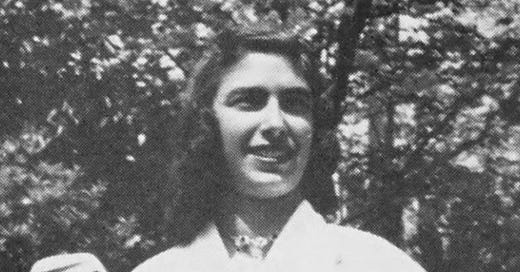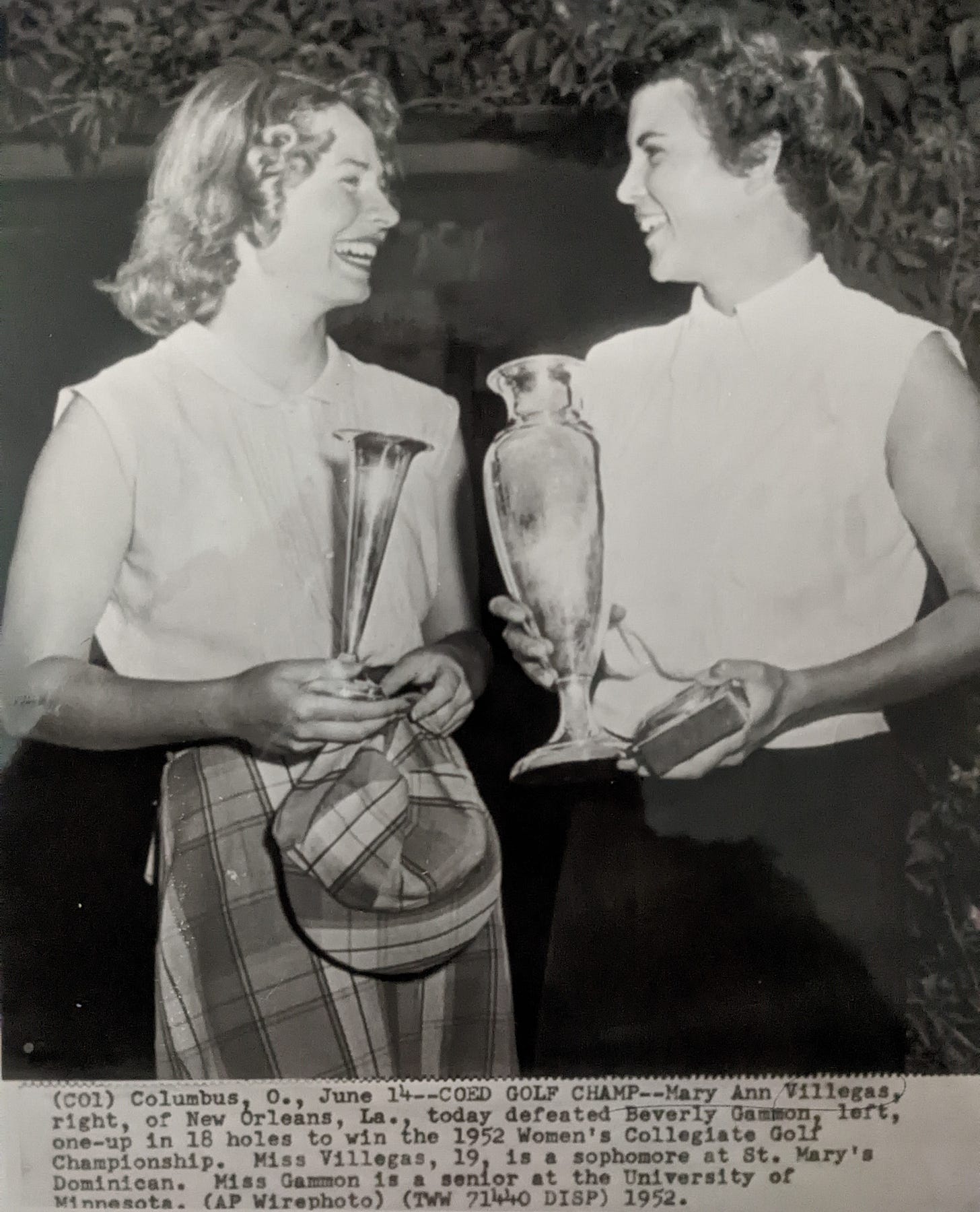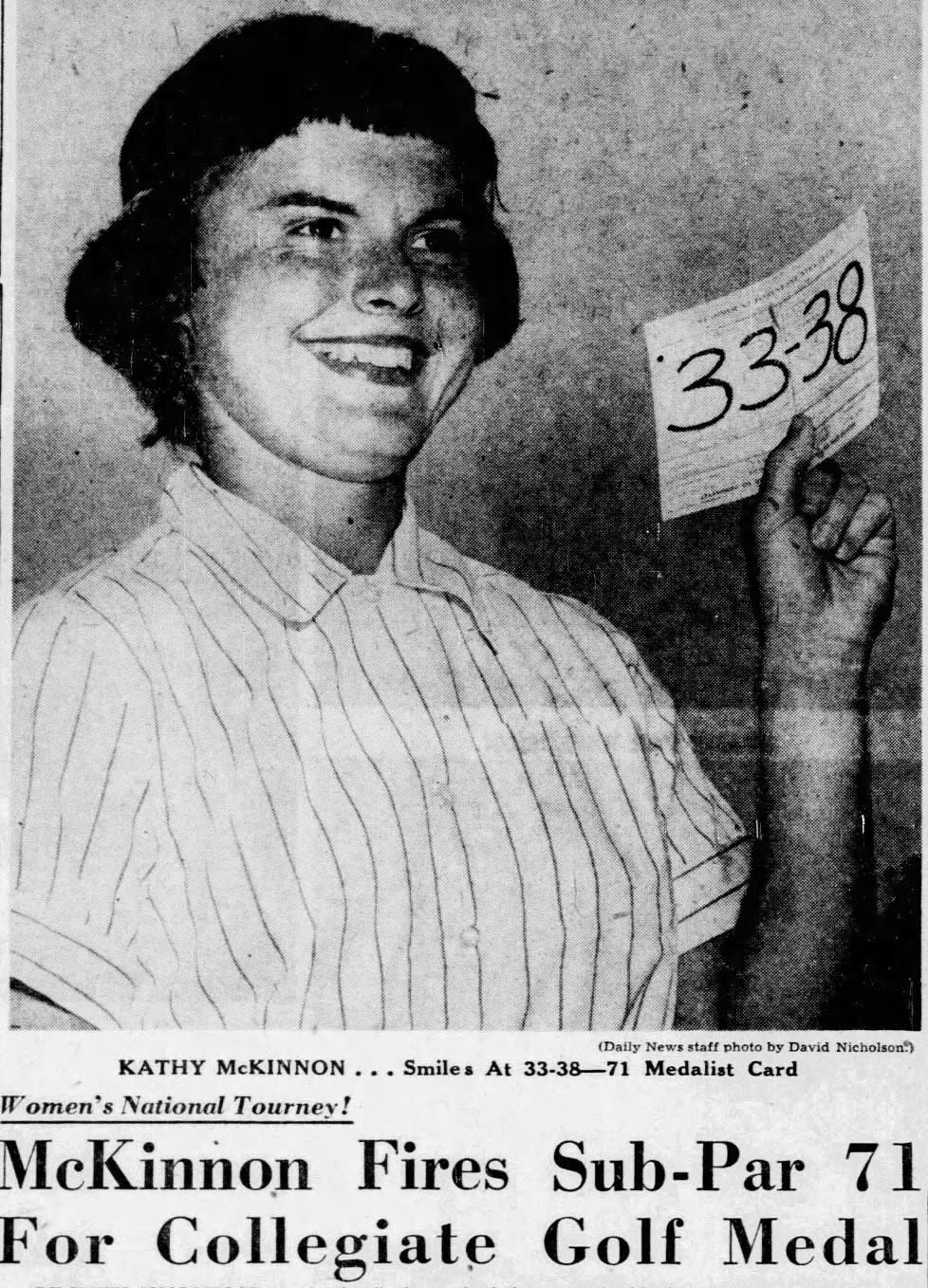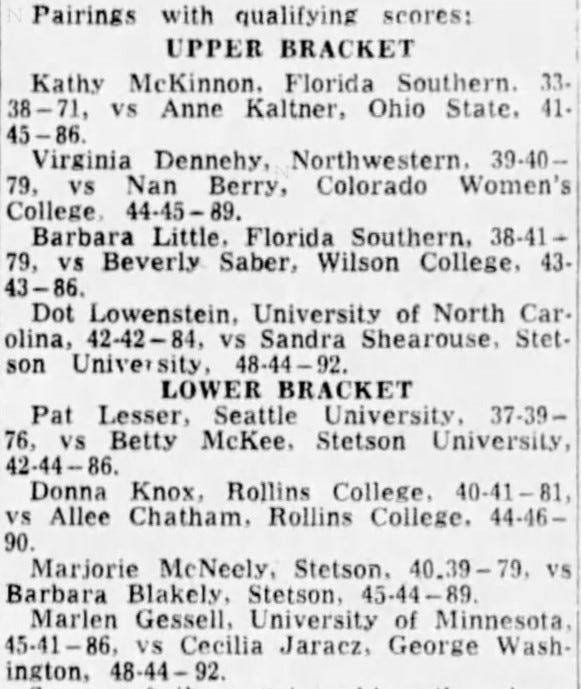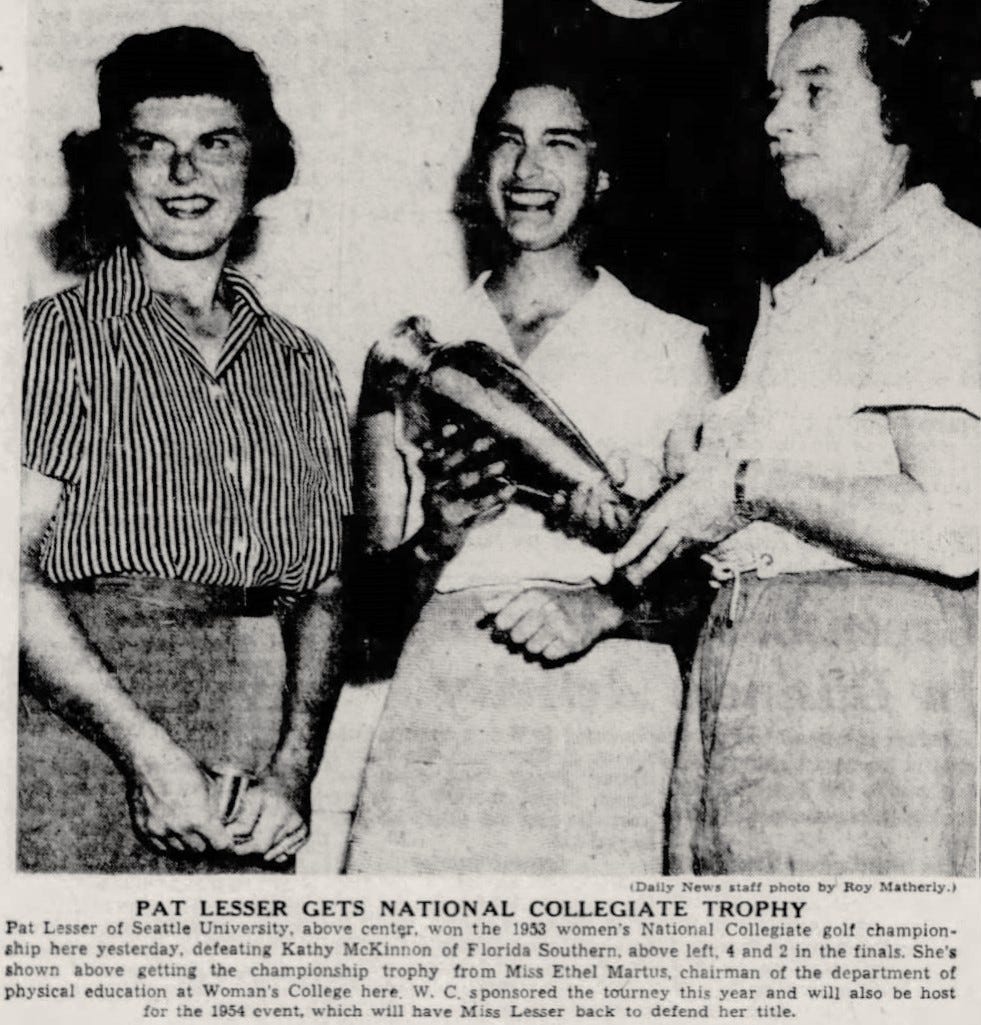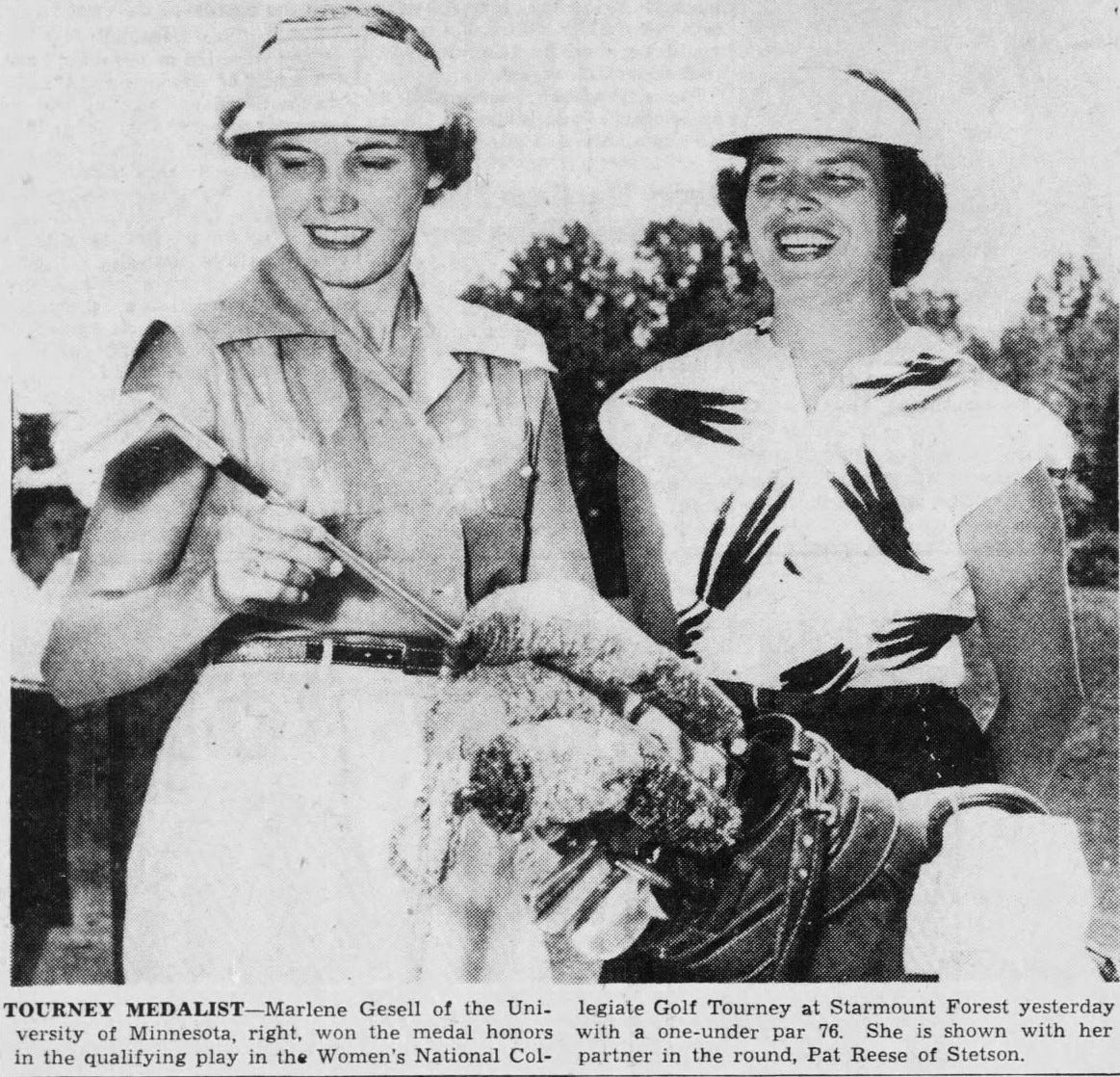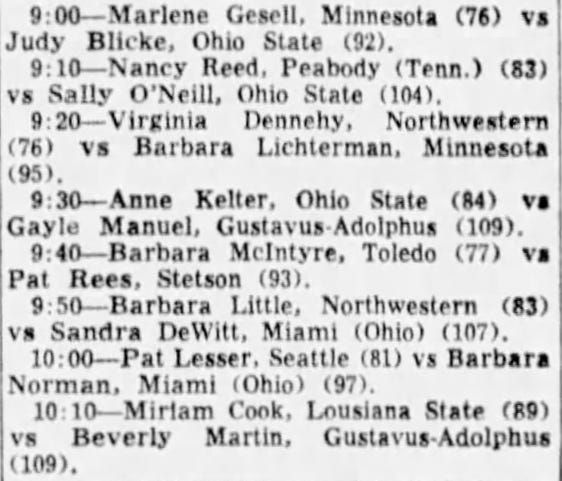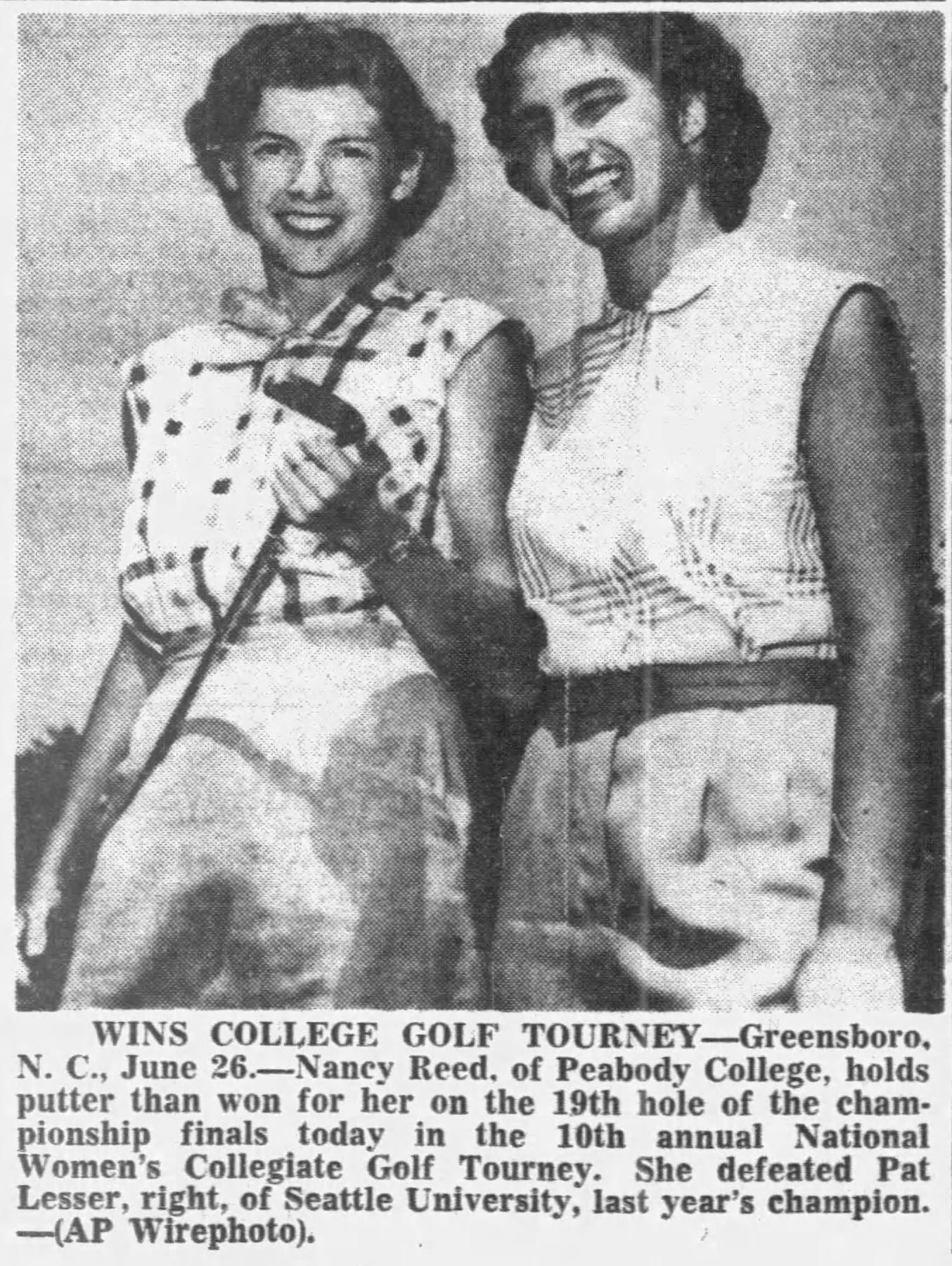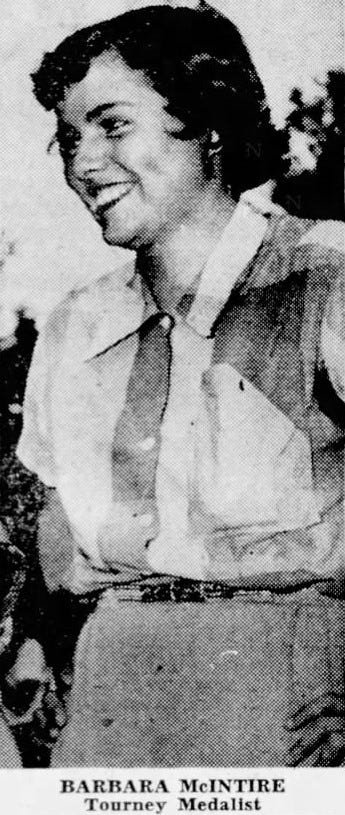This is part of a series on the Women’s Collegiate Championships
By 1951, a combination of mounting financial burden and internal division brought Ohio State to the point where they had no choice but to let the Women’s Collegiate Golf Tournament (championship) find a home away from the Scarlet Course. With no permanent solution lined up or even a firm plan in place for deciding future host sites, the tournament drifted for a few years, being kept afloat by unlikely college institutions. Despite being a time of uncertainty, a common thread through each of the championships was the exceptional play on the course(s), particularly by a Seattle University student named Pat Lesser.
*NOTE 1: underlined text provides a link to references or sites with more information
*NOTE 2: we have done our best to cull out sources that contain problematic language or sentiments, but sometimes those things cannot be helped or are otherwise included to illustrate a point; we hope you understand this usage and recognize its educational purpose is not an endorsement
SAILING AWAY FROM OHIO STATE
The 1951 Women’s Collegiate Championship marked the 10th year and 7th playing of the tournament, all under the guidance and care of the Ohio State athletic department, specifically the Tournament Committee which fell under the auspices of the Women’s Physical Education Department. By this point, the accumulated cost burden of the annual event was becoming a straining point for the organization. Add to that a series of events that resulted in Miss Gladys Palmer’s resignation from her elevated position, and by early 1952 it became apparent that the tournament would be cut loose to either sink or swim (somewhere else).
DISAGREEMENTS
In her 1977 dissertation on The Historical Transition of Women’s Sports at The Ohio State University, Mary Daniels posited that there were two main sources of disagreement that served to fracture the staff cohesiveness - made worse by internal restructuring in 1951 - and eventually led to Palmer’s resignation from her Chairman position.
The first came in 1950 when the Athletic Policies Committee of the Women’s Physical Education Section of the Ohio College Association (the acronym is hardly more helpful here) brought on Mary Yost and Gladys Palmer along with others from Capital University, Wittenberg College, and Miami (OH) University to write guidelines for all Ohio colleges to follow with respect to women’s physical education and, by extension, women’s athletics. The policies that the Ohio State staff had painstakingly cultivated in the last decade were the main source - and in some cases directly copied verbatim - for these “new” guidelines, and some, especially Gladys, felt that Ohio State was not being given proper credit for their role in the final deliverables given to the organization. This apparently led to “a three year ‘feud’ among the women in physical education.”
The second major issue came from Palmer’s choice to place a first-year faculty member in the honored chairman role of the golf tournament. In her defense, that new member was Barbara Canine, who had just finished competing in the tournament the last several years (1948-50) while at Western Michigan and was the 1949 medalist. Even still, this apparently rubbed several of the “established faculty” the wrong way and caused further infighting.
VOTING TO LEAVE, VOTING TO STAY
Following the 1951 tournament, amid discussions trying to resolve the university’s women’s physical education department restructuring, it was “decided that an agenda topic for their October 12 meeting should include making a decision whether or not to sponsor another National Collegiate Golf Tournament for Women at The Ohio State University.”
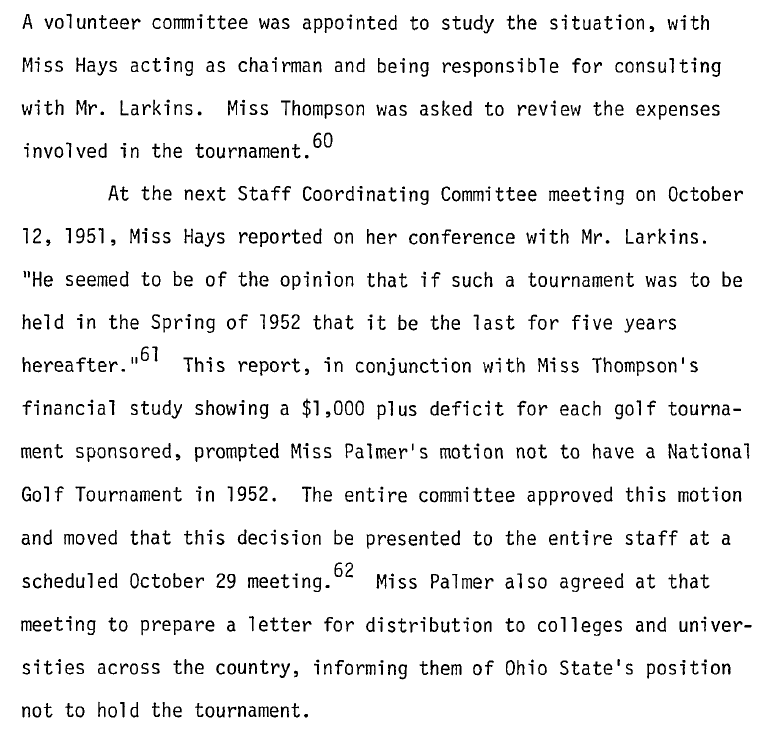
Apparently several key documents that include the minutes from these meetings was lost at the time of this dissertation, as the author was unable to piece together the exact chain of events that led to Gladys Palmer’s resignation as the Chairman of the Women’s Division, but clearly it was “the culmination of the previous months and years of internal disagreement. Richard Larkins, Director of the Department of Athletics and Physical Education at the Ohio State University, called a staff meeting in November, 1951, where he officially accepted the resignation of Gladys Palmer as Division Chairman. It was the end of an era for both Miss Palmer and the University.
Something interesting happened in January 1952. Members of the University Women’s Golf Club, students, and even past participants in the golf tournament all expressed the need for the championship to continue without missing a single year for fear that it might never be revived (again). After a long staff discussion in which volunteers were secured, a vote was initiated - by Palmer no less, who was still a member of the staff although not at an elevated position - and passed for Ohio State to host the championship one final time. Mr. Larkins agreed to support the tournament on the condition that they notify other schools that this was the last one they would host for at least a number of years. If it was to truly be a national championship, he reasoned, then it was time someone else took the helm.
“...[it is] time the baby grew up and started to walk.”
-Richard Larkins, Ohio State Director of Athletics
A FINAL CHAMPIONSHIP BEFORE LEAVING PORT [1952]
Newspaper accounts of the final championship to be hosted by Ohio State - for now at least - barely noted the upcoming change in venue. Depending on how you want to look at it, this could be viewed as either a good or bad thing, but ultimately it seems to speak to a measure of complacency about the tournament which basically bolstered Mr. Larkins’s point. Regardless, the surrounding issues would not overshadow the great play seen on the course for another successful championship.
STROKE PLAY
Ohio State’s one-two punch of Polly Martin an Barbara Little retained the team title, but both fell just short of the 79 shot by Seattle University’s Pat Lesser who took medalist honors. Though just a freshman, Lesser was already well-known in the entire golf community as she was the reigning low amateur from the 1951 US Women’s Open, among other honors we’ll get to later.
The other most notable aspect of the stroke play portion was the 2-for-1 playoff for the final qualifying spot. Louise Camentz [Louisville] beat out Barbara Bremerman [Rollins] and Tommie Riley [Illinois] for her chance at the individual title.
MATCH PLAY
Defending champion Barbara Bruning [Wellesley] had missed the stroke play qualifying with a hurt arm which was bad enough that she wasn’t able to make use of the automatic qualifying spot given to the champ. Both of the eventual finalists had to first log upsets along the way. Beverly Gammon [Minnesota] had to overcome medalist Pat Lesser who played under par all the way up to the semifinals match. Mary Ann Villegas [St. Mary’s Dominican of New Orleans] took an equally tough route to the Finals by upsetting the pre-tournament favorite, Kathy McKinnon [Florida Southern]. Gammon appeared to have the upper-hand when sitting 2up coming off the 13th green, but Villegas stormed back by winning 14 and 15. Playing from the trees on 18, Villegas made an incredible approach shot to 15 feet for a chance at eagle. After Gammon missed her three-foot birdie putt, Villegas calmly sank hers from the same distance to claim the title.
FINDING A TEMPORARY VESSEL
The call put out by Ohio State regarding the need for another school to pick up hosting duties was answered by Ethel Martus, Chairman of the Department of Physical Education at the “Women’s College” in the University of North Carolina network. Today that institution is known as UNC-Greensboro. Martus and other department staff had accompanied players to the tournament at Ohio State over the years, and, as she stated in a letter to Helen Hazelton - her counterpart at Purdue - in 1956, they were “impressed by the ideals, philosophy and standards which were dynamic parts of Miss Palmer’s plan for the Tournament.” While they couldn’t commit to being the long-term replacement host, UNCG was determined to see the tournament continued for at least the next two years. Ellen Griffin and Nancy Porter, golf instructors at the college, would serve as co-chairmen of the event.
THE 1953 CHAMPIONSHIP
The legendary Starmount Forest Country Club, designed by Perry Maxwell and site of the Greater Greensboro Open (now PGA Tour’s “Wyndham Championship”) for the previous decade, offered their course for the 1953 championship. Among the events scheduled to bolster the tournament at it’s new site was a clinic and exhibition match by former players and current pro players, Betty Hicks and Marilynn Smith. Former players from any year were invited to play in a 36-hole “past masters” stroke play tournament. For the current players, driving and pitch-and-putt contests served as added attractions, all meant to convey the fact that the tournament was not going to be a diminished affair just because it left Ohio State.
The deadline for registration was extended beyond the May 31st date, allowing last-minute teams and/or individuals to come out and join the championship. Similar to the first championship in 1941, nobody was quite sure how good the response would be.
One of the interesting notes from reading newspaper accounts of the time is how many refer to the tournament as an “NCAA championship” even though it would still be another 30 years before the first time the NCAA hosted a women’s college golf championship.
STROKE PLAY
Starmount Forest’s par of 76 course was expected to play longer than the 6,400 yards given the soggy condition from multiple days of rain. Instead, Kathy McKinnon [Florida Southern] made a splash by posting a tournament record 33-38=71 (-5). Her three birdies and an eagle on the front nine contributed to a record-breaking score for that part of the course which had last been set by Betty Jameson in the 1947 Women’s Open. In 1956, Kathy (Cornelius) would win her own Women’s Open title by defeating Barbara McIntire in a playoff!
Something to note from both this championship was the lack of a declared team champ. Looking through the scores, it’s easy to see why since few schools sent more than one representative. That said, Florida Southern would have been the winner over the likes of Stetson and Rollins
MATCH PLAY
The medalists from the past two years - Pat Lesser [Seattle] and Kathy McKinnon - seemed destined to meet the in Finals as soon as they were placed on opposite sides of the bracket. Kathy had wins of 5&4 and 3&2 before beating Florida Southern teammate 2&1 in the Semifinals. Lesser rolled with victories of 3&1, 7&6, and 6&5. The Finals match itself was much close than the final 4&2 result would indicated. Lesser was even par through 9 holes and 1up by virtue of winning the 9th hole. That result remained until the 13th when McKinnon’s drive got lost in the woods and it was like she never came back out.
Patricia “Pat” Lesser burst on to the national golf scene in the Fall of 1950 when, at the age of 17, she first won the Western Girl’s Junior Amateur and then the (second ever) US Girl’s Junior Amateur over future legend Mickey Wright. She took her game against older competitors and still found success, gaining Low Am honors in both the 1951 and 1952 US Women’s Open. Since Seattle University didn’t have a women’s golf team, Lesser joined the men’s team and proved her earned spot multiple times over during the 1952 and 1953 seasons. She was the proof positive of both the fact that were female collegiate players with exceptional talents able to compete on men’s teams, as well as Gladys Palmer’s guiding principle that women should have their own dedicated athletics to facilitate those with a high degree of skill. In the last two years Lesser earned a medalist award from the 1952 championship, her university golfing letter, and now the individual collegiate title.
THE 1954 CHAMPIONSHIP
Ahead of the 1953 championship individual match play Finals it was announced that the Women’s College would host the event again in 1954. Excitement for the tournament had been evident even before the conclusion, and the interest generated payed off immediately as Ellen Griffin - UNCG women’s golf and basketball coach - began a class for local juniors at the host club just two weeks later. Upwards of 14 girls participated in that first class much to Griffin’s (and the school’s) delight, proving the gamble and expense in hosting the women’s championship event had been well worth it.
Griffin would go on to become known as perhaps the greatest women’s golf teacher in the country. Her contributions to the game continues to be recognized in the form of the Ellen Griffin Rolex Award presented annually to the LPGA Teacher of the Year since 1989. You can read more about her incredible (and numerous) accomplishments here and here, and even a thesis on her written by none other than Dorothy Germain (the younger) to earn a Master’s Degree from UNCG in 1974!
STROKE PLAY
Starmount Forest CC women’s par had been increased to 77 and clearly played more difficult than last year based on the qualifying scores. Even still, one player did manage to shoot under par - Minnesota’s Marlene Gesell. He 76 was good enough to take medalist honors over Toledo’s Barbara McIntire (sometimes misspelled as McIntyre in newspapers) and Northwestern’s Virginia Dennehy (sometimes mistakenly shown with a score of 76 instead of 78). These three players were the only ones to break 80 amid the unusually high qualifying scores, some eclipsing 100.
Once again there was no official team title, but if there had been it would have been Minnesota over Ohio State, Miami (OH), and Gustavus-Adolphus.
MATCH PLAY
Once again, Pat Lesser seemed destined for the Finals as she steamrolled her competition, winning her matches with scores of 7&6, 8&6, and finally a 4&3 “close” victory over McIntire. Nancy Reed [George Peabody College] was a darkhorse to make the Finals, but she earned her way in with a 4&3 win in the first round, a 6&5 thumping of medalist Marlene Gesell, and finally a narrow 2&1 victory over Virginia Dennehy.
Despite having already taken down two of the best qualifying scorers, Reed, the Tennessee state women’s champ, was given little change against Lesser. To everyone’s surprise, Reed held a 1up lead as the pair made the turn and had even stretched that to 2 with only three holes remaining. That’s when the dramatics began. Lesser fought back and squared the match with a birdie on the 18th after Reed’s own birdie putt hung defiantly on the lip of the cup. Newspaper accounts described the extra hole as “almost anticlimactic” by comparison, possibly due to the fact that Lesser failed to make the par 5 green in regulation and missed a four foot par putt to extend the match. Just like that, David Nancy had beaten Goliath Patricia.
SAVED FROM DROWNING
March 1955 brought with it an announcement that there was a conflict between the Women’s Collegiate Championship and the US Women’s Amateur. This wasn’t a new problem for amateur golf, and in fact was one of the reasons why the men’s championship had been brought under the umbrella of the USGA in 1930 before collegiate golf had fallen under the auspices of the NCAA.
The only recourse for the college women was to move their championship to another venue, but who would step up this time? The answer was, again, from an unlikely source. Lake Forest College is a small institution located in an Illinois town that bears the same name about 30 miles north of Chicago. Polly Martin from the Women’s Physical Education Department was apparently of similar mindset to Ethel Martus of UNCG and Gladys Palmer, and agreed to keep the event going for the year and serve as the tournament director.
THE 1955 CHAMPIONSHIP
Part of the reason for selecting another Midwest school to host was because of the proximity to other important amateur events around the same May-June timeframe, namely the Women’s Western Amateur. Lake Forest specifically had ties to the event not only through participation, but also as being the home town of Northwestern’s Virginia Dennehy who was expected to make another strong showing for the individual title. There was now little concern about a strong attendance at the tournament, but the traditions of surrounding the golf with fun events remained an important element. Some of the additional features such as the driving and pitch-and-putt contests were continued as well.
STROKE PLAY
The beautiful Seth Raynor designed Shoreacres Country Club played at a short but tough par 73. Pat Lesser shot a respectable 79 along with Anne Richardson, but it was Anne’s Rollins teammate Barbara McIntire - who had transferred from Toledo since appearing in last year’s championship - whose 76 ruled all for medalist honors. McIntire was already a Western Junior Am winner (1952), but in just a few short years she would win the Women’s Western Amateur (1958, 1963) and would become only the 5th player to hold both the US (1959, 1964) and British (1960) Women’s Amateur titles at the same time.
For the third year in a row, no official team champion was declared. This time it was Rollins who missed out on adding hardware to their trophy case and official record book.
MATCH PLAY
Match play for the individual title started off with a bang. The surprise of the tournament was Pat Lesser’s first round exit at the hands of Berridge Long of Sophie Newcomb College. Miss Long, however, was not done. She followed that epic win with two more - the second over medalist McIntire 4&3 - which earned her a spot in the Finals. Her opponent was Jackie Yates [Redlands] who scored victories of 5&3, 6&5, and 3&2
The title match was a one-sided affair. Jackie Yates, University of Redlands hall of famer and pride of Hawaii, took the lead on the 7th hole and wouldn’t give it up. Ultimately, Berridge Long’s magic ran out as she succumbed to Yates 5&4.
HOPE ON THE HORIZON
Despite another successful tournament, the cost burden of the event proved too much for the small Lake Forest College and they could not commit to hosting again for 1956. Two former players, dismayed at the tournament once again being on the brink of capsizing, reached out to the University of Illinois’s Chairman of the Department of Physical Education for Women, Dr. Laura Huelster, for help. This proved to be a fortuitous move. Although Illinois was unable to host the event due a scheduling conflict at their course, she made a call to her counterpart at Purdue University, Helen Hazelton, who agreed to host for 1956.
With the immediate problem solved, Dr. Huelster used the occasion of an Intramural Conference in Washington D.C. in November, 1955, to discuss the matter with several key people representing three national organizations involved with women’s athletics. As it turned out, several of these same people had apparently also informally spoken with Ohio State’s new (as of 1953) Chairman of the Women’s Division, Dr. Margaret Mordy, about the importance of the golf championship continuing. This group of people would help form a three-organization partnership that provided an island of stability in the sea of uncertainty.
Thanks for reading!
Up Next: The Tripartite and Marlene Stewart (1956)
In the next post for this series, we will cover the championship gaining new oversight and official structure that will provide firm ground, allowing it to finally walk on its own. The winner that year, Marlene Stewart (later Streit) has quite the incredible story.

